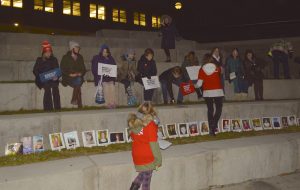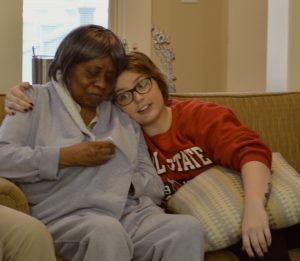Bearings
Peacemaking in the Middle
By Nick Nagy
January 2018 Issue

I was back in “the middle” this holiday—back in Indiana, the flyover state I call home.
Indiana has garnered much attention these past two years as the current Vice President hails from the state. Unfortunately, the presidential election of 2016 might have you thinking that Mike Pence is a good representation of what it means to be a Hoosier. But Pence has a sad and, frankly, destructive record in Indiana of attacking the health options for women and drug addicts, limiting civil rights, and turning away refugees that was unpopular even when he was governor of the state. Not all Hoosiers believe in this kind of indecency and most do not share in Pence’s lack of empathy. In fact, alongside the heartless conservatism of Pence and his ilk sits a heartland humanitarianism of which many people are unaware.
For instance, a panel entitled “Common Decency and Refugees” held at the Kurt Vonnegut Memorial Library in Indianapolis gave me a glimpse of how Hoosiers strive for peace in their communities. Many people don’t know that Vonnegut, as much satirist and left-leaning cultural critic as he was novelist, was from Indiana. Vonnegut spoke to the cultural insularity that often characterizes Midwestern states like Indiana in the coastal American mind. He railed against it in a 1973 interview:
A first grader should understand that his or her culture isn't a rational invention; that there are thousands of other cultures and they all work pretty well; that all cultures function on faith rather than truth; that there are lots of alternatives to our own society. Cultural relativity is defensible and attractive. It's also a source of hope. It means we don't have to continue this way if we don't like it.
The panel was held at the library that honors Vonnegut and carries forward his hopeful vision. A refugee named Fikiri detailed his experience in the former country of Zaire in Africa. He told a story about how the neighboring countries were warring internally while his country was seemingly in a state of peace. Because of this, Zaire saw an influx of refugees from these countries and Zaire’s citizens became upset, wanting the refugees to “go back where they came from.” He said that it was not until he found himself and his country in the midst of a violent war that he realized he, too, was a refugee who sought help from those around him. He experienced the fragility of peace firsthand. From this he concluded that we are all refugees. We cannot know when our communities will be wrecked or consumed by violence or hardship, and we all often find ourselves at points of time just wishing we could have a little more help to keep us going.
After the panel, I walked across the street to a small garden called the “Pathways to Peace Garden,” where I couldn’t help but think about the similarity that this location shared with the Midwest in general. People are quick to walk or fly right past these places in their rather busy lives, but this one seemed to mark a quiet awareness in the hearts of the Hoosiers I encountered at the Vonnegut Library of the hope that is generated by conversations with those who are thought of as “outsiders” by too many Americans. These were not flyover bystanders who falsely conceive peace as limited to the absence of violence, who assume others will do the necessary work, and that as long as we don’t commit physical violence, we are contributing to peace. Out in the middle of America, a landscape written off by many Americans as hopelessly isolationist and dismally Trumpian, my neighbors were getting into the thick of the peacemaking enterprise through engagement, conversation, and action.
 I saw more of this on the fifth anniversary of the Sandy Hook school shooting when I attended a candlelight vigil in remembrance of those affected by gun violence at Sandy Hook, in Indy, and around the U.S. The group that organized the event—a group that was started by a mother in Indianapolis—is called Moms Demand Action for Gun Sense in America. One mother told about how her son had been struck by a stray bullet while at a birthday party. This boy was in the right place at the right time but even that was not enough to protect him from the carelessness of some individuals and the surplus of guns in this country.
I saw more of this on the fifth anniversary of the Sandy Hook school shooting when I attended a candlelight vigil in remembrance of those affected by gun violence at Sandy Hook, in Indy, and around the U.S. The group that organized the event—a group that was started by a mother in Indianapolis—is called Moms Demand Action for Gun Sense in America. One mother told about how her son had been struck by a stray bullet while at a birthday party. This boy was in the right place at the right time but even that was not enough to protect him from the carelessness of some individuals and the surplus of guns in this country.
A little girl spoke about how those murdered in Sandy Hook would have been the same age as she is today. She talked about her mothers’ experience as a teacher and how both of them could have been victims in a shooter scenario such as the one at Sandy Hook. It’s heartening that a 6th grader is so aware of the need for change that she goes out and actively engages in trying to create peace moving forward. Still, there is also something sad about the fact that someone so young has to be worried about such things. Yet there she was on a cold Indianapolis night, joining her mom in refusing to be idle in the face of injustice.
Peacemaking goes right to the heart of families out in the Middle, into the center of domestic life. This was made clear to me during a regular volunteer gig at a daycare facility, Joy’s House for Disabled Adults, where most of the people have Alzheimer’s or dementia. The guests at this daycare seem to value peace and love over all else. When disputes break out between guests, others are quick to try and settle them and mediate peace. Some of the guests even attribute this peacemaking impulse to their old age, saying they are too old to be fighting or acting inconsiderate.
 Of course, peace is not always constant in this place, as some guests vary in their cognitive abilities. Some have a rather hard time understanding why another may be yelling for no reason and so they tell them to "shut up" when really the person yelling is not aware of where they are or what they are doing. However, the idea that peace needs to be mediated between all the guests in the house is a constant. This is true of the guests and the staff as they all work to make sure that everyone gets along.
Of course, peace is not always constant in this place, as some guests vary in their cognitive abilities. Some have a rather hard time understanding why another may be yelling for no reason and so they tell them to "shut up" when really the person yelling is not aware of where they are or what they are doing. However, the idea that peace needs to be mediated between all the guests in the house is a constant. This is true of the guests and the staff as they all work to make sure that everyone gets along.
Such intimate, interpersonal gestures may seem tangential to the larger idea of peacemaking, but I think it’s imperative that we learn to cultivate peace in our interpersonal relationships—with the uncle who spews Fox News disinformation at dinner or your Bernie Bro cousin who you can’t help but think threw the whole election—or else we will struggle to obtain peace on a larger scale. Joy’s House serves as an example of how peace can be worked for in this day-to-day, person-to-person way.
It turns out that, despite the characterizations of people in the Midwest I sometimes hear when I’m back at school on The Left Coast, peacemaking is thriving in the heartland. Maybe we walk a slower, steadier path. Maybe we speak in smaller clusters of conversation rather than grand, dramatic demonstrations. But we're on it in our own way.
While I was back home, we had a particularly bad cold snap. The effects of the so-called Bomb Cyclone that seized upon the Eastern Seaboard turned out not to be a whole lot of fun in Indiana either. But out in the flyover states, we know a thing or two about waiting out the cold, gathering together and attending to small signs of warmth, growth, and new life that’s bound to come. This is the heart of peacemaking in the Middle.
Photo Credits:
All photos by Nick Nagy (2017). CC2.0 license. Recolored, cropped.

